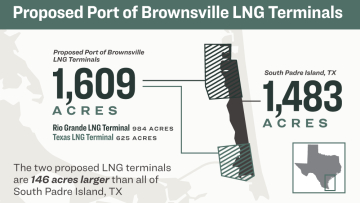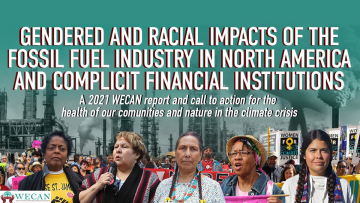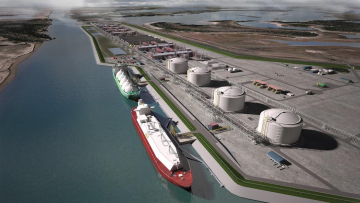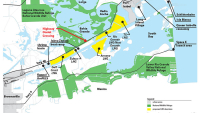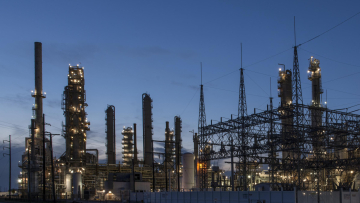
Project – On record
This profile is no longer actively maintained, with the information now possibly out of dateBankTrack & Rainforest Action Network
Alison Kirsch, Climate and Energy Program and Research Coordinator, Rainforest Action Network
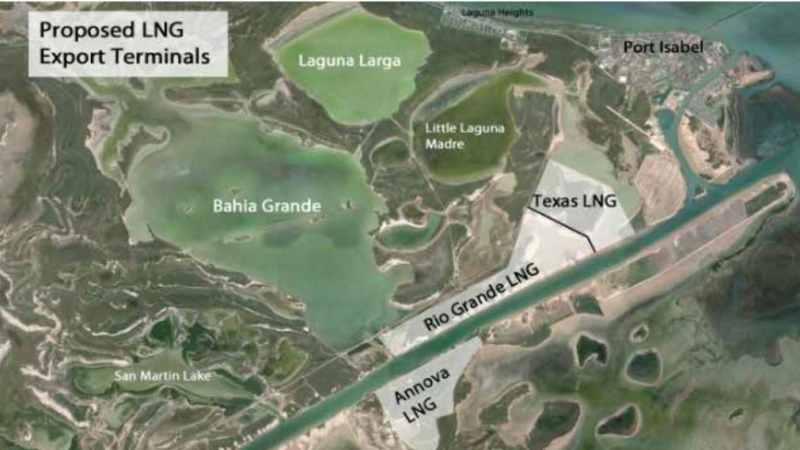
Project – On record
This profile is no longer actively maintained, with the information now possibly out of dateBankTrack & Rainforest Action Network
Alison Kirsch, Climate and Energy Program and Research Coordinator, Rainforest Action Network
Why this profile?
The proposed Annova LNG terminal would be located close to coastal wetlands and threaten the Bahia Grande area of the Laguna Atascosa National Wildlife refuge, where wetland restoration is still ongoing.
What must happen
In general LNG export terminals are capital-intensive, financially risky and environmentally destructive. Financial institutions involved in these projects share responsibility for the impacts of these facilities. These impacts span people and ecosystems across the continent: communities around the terminal site, communities at the point of extraction and communities along the pipeline routes.
By financing practices that are incompatible with a climate-stable future, the financial institutions involved threaten the global agreement to address climate change. Therefore, banks involved should withdraw their commitment to this project.
| Sectors | LNG Terminal |
| Location |
|
| Status |
Cancelled
Design
Agreement
Construction
Operation
Closure
Decommission
|
| Website | http://annovalng.com/ |
In the port of Brownsville in Texas, Exelon is planning to build the Annova LNG export terminal. If built, the LNG terminal would sit beside the Brownsville Ship Channel and require 650 acres of land. The proposed site is about eight miles from the Gulf of Mexico. The facility would be operational by 2022 and is expected to export 6.5 million tonnes yearly. The project is estimated to cost USD 3 billion. Next to this LNG Terminal, there are two other terminals planned to be constructed in the Port of Brownsville (Texas LNG and Rio Grande LNG).
Social and human rights impacts
The public health impacts of climate change in U.S. Gulf Coast states—Texas, Louisiana, Mississippi, Alabama, and Florida—may be especially severe and further exacerbated by a range of threats facing the coastline areas, including severe erosion, subsidence, and—given the amount of energy production infrastructure—the ever-present potential for large-scale industrial accidents. The Gulf Coast population is expected to reach over 74 million by 2030 with a growing number of people living along the coastlines. Populations in the region that are already vulnerable because of economic or other disparities may face additional risks to health and well-being as a consequence of a changing climate, creating new levels of concern for political and public health leaders.
Communities that would feel the negative impacts of the LNG terminals are often low-income people of colour. The Annova LNG terminal will be located between the Laguna Madre communities and next to Brownsville, a rural community that is 93 percent Hispanic or Latino. More than 35 percent of the Rio Grande Valley's residents live in poverty, the highest rate of any metropolitan area in the United States. Already this region struggles with major health issues. These projects would add thousands of tons of pollutants into the air. Across the United States nearly 1.78 million Latinos already live in areas that face a cancer risk above the EPA's level of concern from toxins emitted by oil and gas facilities. Industrial ozone smog burdens Latino communities with 153,000 childhood asthma attacks and 112,000 lost school days each year.
If built, this LNG terminal could significantly impact the local fishing, shrimping and ecotourism industries. Nearby South Padre Island could have its beauty and its economy compromised by the release of effluent water, and the brown haze that would come with the thousands of tons of air pollution.
In the Rio Grande Valley, nature tourism alone leads to 6,600 jobs. In contrast, an LNG terminal creates mostly temporary construction jobs and only a few hundred permanent ones.
For more information on the gendered and racial impacts of the fossil fuel industry in North America, including this LNG terminal, see WECAN's 2021 report "Gendered and Racial Impacts of the Fossil Fuel Industry in North America and Complicit Financial Institutions".
Environmental and climate impacts
The terminal is proposed right on the edge of what the US Fish and Wildlife Service calls "one of the largest and most succesful coastal wetland restoration projects in the US": the Bahia Grande unit of the Laguna Atascosa National Wildlife refuge, where wetland restoration is still ongoing. The 21,700 acre refuge is a safe haven for a range of species and native vegetation, as well as a crucial storm barrier. Endangered ocelots and Aplomado falcons roam this area. As of August 2015 only 53 ocelots were left in Texas, all in this area of the state. Construction, bright lights, tall structures, air pollution and wastewater will fundamentally alter the ecosystem of the area.
With these three terminals (Rio Grande LNG, Texas LNG and Annova LNG) exporting at full capacity, burning just one year's worth of the gas exported from Brownsville would create greenhouse gas emissions equivalent to the annual emissions of 30 coal-fired power plants. Accounting for extracting, piping, liquefying and shipping the gas nearly doubles the carbon intensity of energy produced from RGV's exported LNG. LNG is the most carbon-intensive form of natural gas.
In May 2016 Annova LNG's parent company Exelon extended its revolving credit facility, financed by thirty financial institutions, to USD 600 million (maturing in May 2021). See below for details on financial institutions involved.
2021
2021-03-22 00:00:00 | Annova LNG project cancelled
On 22 March 2021, Annova announced the “immediate discontinuation” of the 6.5 million metric tons/year (mmty) export project in a letter filed Monday with FERC. The letter asked the Federal Energy Regulatory Commission to vacate the project’s authorization. (Natural Gas Intelligence). Annova LNG, backed by Exelon, Black and Veatch, Enbridge, and Kiewit Energy group, was one of three fracked gas export terminals proposed for the Rio Grande Valley. If built, Annova LNG would have destroyed wetlands, blocked a wildlife corridor threatening the survival of endangered wildlife, and put communities needlessly at risk. (Sierra Club)
2020
2020-04-20 00:00:00 | Lawsuits challenge approval of Rio Grande and Annova fracked gas export facilities in Texas for harm to endangered Ocelot
Today, environmental groups filed a lawsuit challenging the U.S. Fish and Wildlife Service’s (FWS) approval of the massive Annova LNG fracked gas export terminal proposed for southern Texas. The suit was filed in conjunction to one the groups filed last week challenging the Rio Grande fracked gas export facility proposed for the same area. These projects threaten to contribute to the extinction of the endangered ocelot in the U.S.
2019
2019-11-22 00:00:00 | FERC authorizes Annova LNG project
Annova LNG received its FERC authorization from the U.S. Federal Energy Regulatory Commission (FERC) to construct and operate its mid-sized liquefied natural gas (LNG) export facility located in Brownsville, Texas (Annova LNG press release).
2019-04-19 00:00:00 | Annova LNG receives final Environmental Impact Statement from FERC
Annova LNG received its final Environmental Impact Statement (EIS) from the U.S. Federal Energy Regulatory Commission (Annova LNG press release).
2017
2017-08-01 00:00:00 | Final Investment Decision expected in Q2 2018
According to AnnovaLNG the Final Investment Decision is expected in early 2018, depending also on FERC approval (source AnnovaLNG).
2016
2016-11-01 00:00:00 | FERC requests analysis of risks associated with the proximity of SpaceX launch pad
Federal Energy Regulatory Commision (FERC) has requested that the companies behind three proposed LNG terminals hire external experts to determine the risks of having the SpaceX launch pad nearby, in case of a failed launch. This request comes after a failed rocket launch on September 1st, during which a rocket exploded. FERC has deemed the additional information necessary to complete the Environmental Impact Statement.

